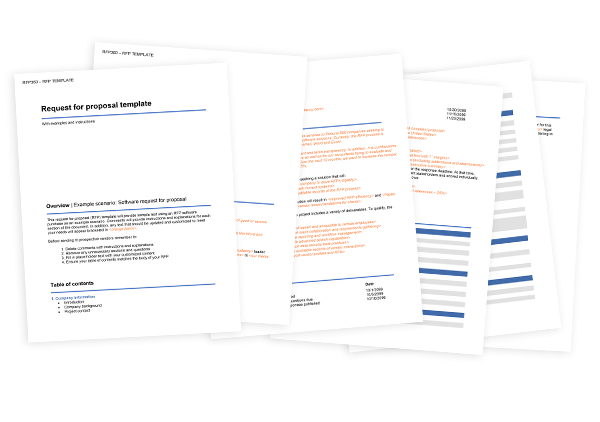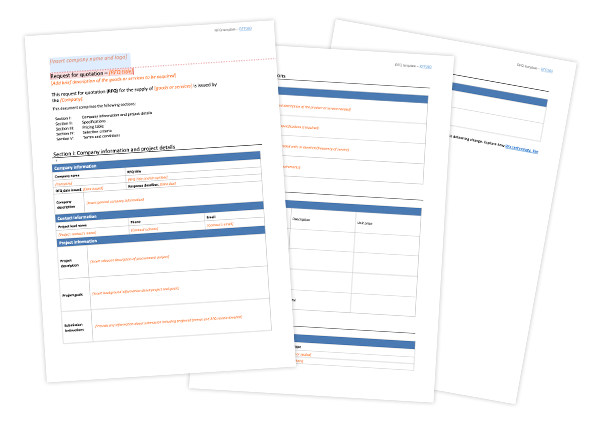How do you know if you should use an RFI vs RFP vs RFQ? It all comes down to what you’re trying to accomplish. While they all help organizations gather information from vendors, they each serve a distinct purpose. Used independently or together, RFIs, RFPs and RFQs are all important tools for reducing risk, saving money and picking the perfect partner.
So, what IS the difference between an RFI, RFP and RFQ? Here’s the short answer:
- The request for information educates — RFIs explore potential solutions that vendors offer
- A request for proposal compares — RFPs evaluate the overall value a vendor can offer
- The request for quotation quantifies — RFQs detail the cost of meeting a specific need
But, that’s just the beginning.
In this article we’ll explain everything you need to know (and more) about what RFIs, RFQs and RFPs are. We’ll break down the purpose of each document and how to select the right one. And, finally, we’ll share our favorite examples and resources for learning even more.
Admittedly, there’s a lot to cover here. So, use the link below to jump to each section, or download this guide as a PDF to save and reference as needed.
Key definitions to know: RFI, RFP, RFQ
Admittedly, there’s a lot of jargon and acronyms involved in procurement and information requests. So, before we dig into the differences between each of these documents, let’s cover a few key definitions.
To explore more procurement and RFX terminology, download the RFP from A-Z glossary.
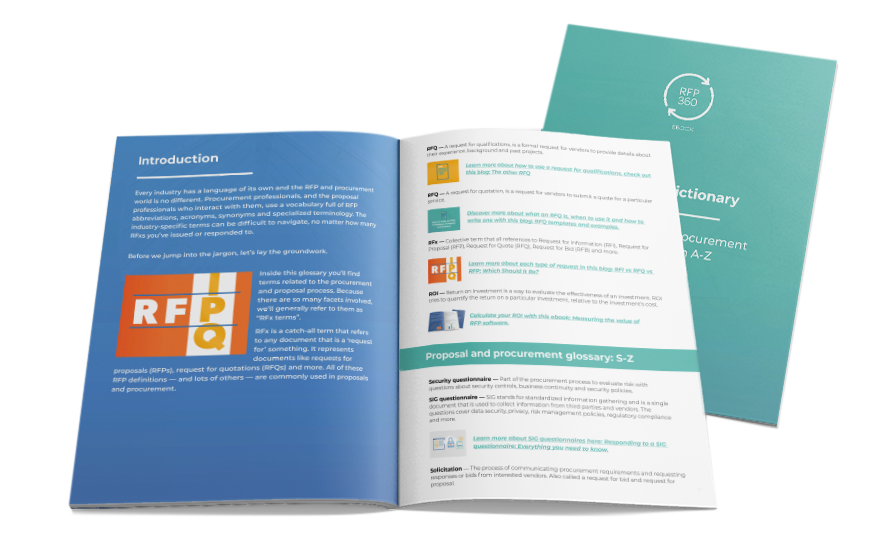
What is an RFX?
The acronym RFX stands for request for ____ (fill in the blank). It’s a term used to collectively refer to any questionnaire request issued by a buyer to a vendor. So, RFX could stand for RFP, RFQ, RFP and so on.
What is an RFI?
The acronym RFI stands for request for information. A request for information is a questionnaire used to ask vendors about their products and services. Often, RFIs gather general information, market details and solution ideas for planning purposes.
What is an RFP?
RFP is the acronym for request for proposal. A request for proposal is a detailed questionnaire used by buyers to collect decision-critical information from potential vendors. The RFP is one of the most commonly used tools for evaluating vendors and documenting selection justification.
What is an RFQ?
RFQ is an acronym that stands for request for quote or quotation. A request for quotation is a document that details a buyer’s needs and asks vendors to respond with a detailed pricing proposal. Generally, a buyer issues an RFQ when looking for the lowest possible price.
The RFI vs RFQ vs RFP guide
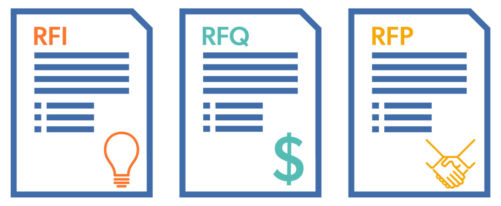
Request for information
Purpose: When you’re looking for information or you’re not sure what solution might solve your problem
Asks: General questions designed to educate and inform
Style: Casual, asking for help
Advantage: They’re fast and help inform next steps to meet business needs
Request for proposal
Purpose: When you’re ready to shop around and evaluate many factors before making a choice
Asks: Specific, detailed questions about the service, product and vendor’s business
Style: Formal and direct
Advantage: Provides a clear comparison of vendor offers and capabilities
Request for quotation
Purpose: When you know exactly what you want and why, but need to explore all of the financial details
Asks: Questions about what it will cost to meet the requirements
Style: Structured and prescriptive
Advantage: Removes distractions and allows buyers to focus on price
How are RFIs, RFPs and RFQs related?
Each RFX achieves a unique goal. However, the core purpose of every RFI, RFP and RFQ document is to help select the perfect vendor. According to Kevin Iwamoto, senior consultant at Goldspring Consulting,
“All three have been used globally for decades to obtain relevant information from potential suppliers and are meant to create and establish a fair and equal weighted process where all vendors, incumbent and potential, have a chance to become a ‘preferred’ supplier for a corporation. They have been instrumental in enterprise risk mitigation, process standardization, cost savings and cost avoidance.”
The practice of managing RFIs, RFQs and RFPs is called request management. While sourcing professionals and procurement consultants work with RFX tools daily, they are also useful to others. For example, a small- or medium-sized business that doesn’t have a dedicated procurement department may require department heads to use an RFP before making large purchases. Generally, this is to ensure a thoughtful, objective and financially-sound decision.
For high-value, strategic purchases, a multi-step process is wise. For example, when selecting a new accounting software to replace an old solution you may have a list of needs including a few custom requirements. Technology moves so quickly that starting with an RFI can help you explore new functionality that you may not be aware of. Then, once you know what features you need, you can narrow your vendor selection and send a more detailed RFP.
RFI (Request for information)
Overview
An RFI is the most casual of all the RFX options. It asks general questions about vendors and the market landscape. Rather than sending an unstructured email to potential vendors, a request for information provides a standardized format, which is easier to review. Additionally, RFIs are a quick way to fill in gaps in your own research. According to TechTarget,
“An RFI is typically the first and most broadly cast of a series of requests intended to narrow down a list of candidates.”
RFI basics
- Serves as a casual introduction to vendors
- Offers a general overview of the vendor landscape
- Asks open-ended, high-level questions
- Used in the early stages of the buying process to refine vague project requirements
Tips for writing an RFI
When writing your RFI, there are a few things to remember.
- Give responders context — tell them about your challenge and goals
- Let vendors confirm or challenge the research you’ve conducted independently
- You don’t need to make any promises or commitments, you’re simply gathering information
- Keep it short to encourage and maximize vendor engagement
- Seek their perspectives, not detailed capabilities (you’ll judge these later)
- Ask if they have any questions, while it may seem counterintuitive, it can give valuable insight
- Cast a wide net, you’ll narrow your selection later in the process
RFI example scenario
ABC Company wants to strengthen their relationship with customers through social media channels. They currently maintain a Facebook page, Twitter account, and LinkedIn presence.
The challenge is to engage current customers and use their networks to refer your products and services to peers. Based on this scenario, here are some RFI questions you might ask:
- What social media channels do you consider to be important for ABC Company and why?
- What are your initial impressions of our social media presence?
- How do you measure ROI for social media activities?
- For efficient integration between our internal marketing and external service providers, what people, process and technology factors do you think are important to consider? Are there any limitations you need to know about?
- What social media channels do you consider to be important for ABC Company and why?
- What are your initial impressions of our social media presence?
- How do you measure ROI for social media activities?
- For efficient integration between our internal marketing and external service providers, what people, process and technology factors do you think are important to consider? Are there any limitations you need to know about?
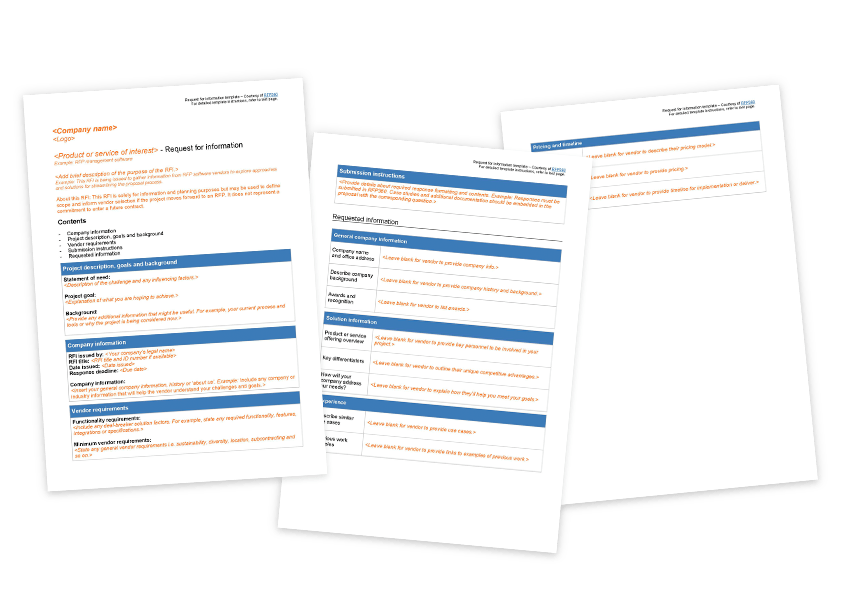
RFP (Request for proposal)
Overview
An RFP is a formalized and structured way of getting specific vendor information (including pricing). It allows you to detail the problem you wish to solve and invites vendors to suggest solutions. Indeed, RFPs are very thorough and offer a side-by-side, fact-based comparison of vendors’ capabilities.
According to Hubspot,
“RFPs give you a sneak peek into different strategies you may not have considered since each vendor will include their own unique action plan along with their bid.”
RFP basics
- Shares background information about your problem, process and needs
- Includes detailed questions about the vendor and solution
- Offers specific parameters for the services and products you’re seeking
- Indicates you moved beyond exploration and are ready to buy
- Compares vendors based on your unique priorities
Tips for writing an RFP
When creating an RFP, keep these tips in mind:
- If you’re looking for specialized or customized service, ask to see an example of that kind of work done for other clients
- Avoid sticker shock by requiring a comprehensive pricing plan
- Be as in-depth as you need to be. At this point, you’re both invested, so make sure your priority questions are as thorough as they need to be
- If you’re unsure of a seller’s expertise or competency for your needs, address it. Ask them for the examples, certifications or references that will put you at ease
- Avoid vague questions — you have specific expectations, whether you realize it or not. So, if you’re having problems writing exact requirement questions, collaborate with someone outside the situation who can help challenge assumptions
Example RFP scenario
Your company needs to acquire new accounting software. Beyond getting pricing and approach details, the RFP is a great place to get info on how you will work together. Ask how you can reduce risk, save time and save money. Here are some sample RFP questions to consider:
- How will you approach the implementation of the software? What are your plans to ensure optimal adoption?
- What steps can we pursue to control costs and limit cost overruns? How will you work with us to ensure we maximize value without increasing costs?
- What risks to the timeline or budget do you see, based on your understanding of our organization? A high-level question like this gives you a sense of how much thought or effort they’re putting into their response
- How are you monitoring and staying ahead of trends in our industry? What do you do to encourage innovation?
RFQ (Request for quote)
Overview
An RFQ is a request sent to vendors for pricing and payment information. Generally, it includes detailed requirements and deliverables. Unlike the RFI and RFP, the RFQ rarely includes questions, because the buyer must already know exactly what they need. Indeed, only use this document if you are well aware of marketplace conditions and offerings. An RFQ means that a purchase is imminent and the list of needs detailed in the request rarely changes.
According to Investopedia,
“When the soliciting company knows the exact number or type of product or services it desires, it customarily uses an RFQ. Typically, companies use an RFQ when products and services are standardized, or off-the-shelf.”
RFQ basics
- Includes a list of detailed requirements
- Centers around deliverables, costs and payment terms
- Used when you already know exactly what you’re looking for
- Indicates vendors’ ability to provide the requested services and goods as requested
- Offers with the lowest price generally win
Tips for writing an RFQ
When writing an RFP, you’ll want to keep these things in mind:
- Provide minimal background and a list of requirements
- Detail your needs in a list of products, features and functionality required
- Include the quantity of goods or duration of service required
- Provide a timeline for expected delivery
- State your preferred payment terms
- Include a pricing table or form for consistency
Get more tips from this detailed RFQ guide with templates and examples.
RFQ example scenario
If your organization needs to purchase new janitorial supplies, your RFQ may include the following items:
- Multi-surface cleaner – Cost per ounce: $______
- 13-gallon, 1 mil trash can liner – Cost per 100: $______
- 1.2-gallon, .55 mil small trash can liner – Cost per 100: $______
- Hand soap – Cost per ounce: $______
- 8″ paper towel roll – Cost per 800 ft. roll: $______
- Weekly delivery cost: $______
- Net 60 payment terms: Yes or no
When should you use an RFI vs RFP vs RFQ?
Once you understand the differences between an RFI, RFP and RFQ, it’s much easier to decide which to use. Indeed, the first step is to clearly establish what you’re trying to achieve.
Start by answering these questions:
- Do you know what questions to ask a vendor?
- Are your questions very specific or more general?
- Do you already have a preferred vendor list (a shortlist)?
- Do you need to bid out the work through a formal RFP process?
- Are you working with repeat or first-time vendors?
- Do you know exactly what you’re looking for, or would you like vendors to make suggestions?
You should also have an internal discussion to get answers to these questions. Find additional RFP questions to ask your team in order to avoid setbacks down the road.
Quick guide on how to decide
Bottom line, which one is for you: RFI, RFQ or RFP?
- If you’re shopping for very specific services and know exactly what you want, then an RFQ is your best best
- However, if you’re close to a purchase but open to ideas, an RFP is probably the way to go
- Finally, if you’re just trying to get an overview of your vendors or see if there’s a solution to your pain, then the simpler RFI might be the better choice
Regardless of which RFX you use, RFP software can help. To explore how an RFP management system could improve your procurement process, schedule a demo.
RFI, RFQ, RFP summary
Originally published September 29, 2017, updated February 17, 2022

